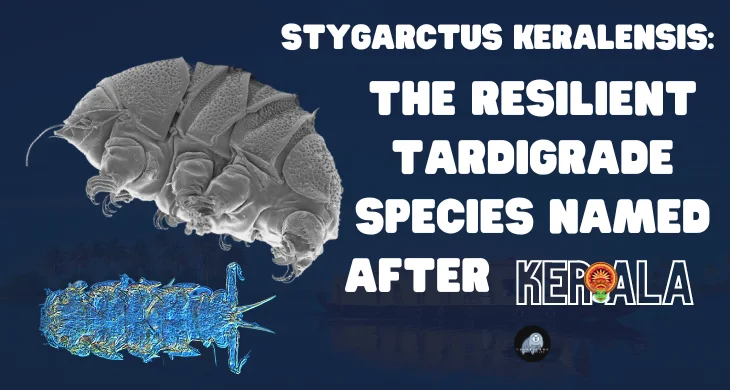In the heart of Kerala, India, amidst its lush landscapes and thriving ecosystems, a remarkable discovery has emerged from the microscopic world—the Stygarctus Keralensis, a tardigrade species that showcases the incredible resilience of life. Join us on a journey into the depths of this unique discovery, as we unravel the story of this tiny yet mighty creature and explore its significance in the world of science and biodiversity.
A World of Tiny Marvels:
In the enchanting opening section of our blog, we embark on a journey into the mesmerizing world of tardigrades, those captivating microscopic wonders that have held scientists and nature enthusiasts spellbound for generations. Here, we invite readers to step into the realm of the minuscule, a realm where the ordinary becomes extraordinary.
Microscopic Wonders Unveiled: We begin by peeling back the layers of the unseen, unveiling a world where the tiny reigns supreme. Tardigrades, often measuring less than a millimeter in length, emerge as the stars of this hidden universe. We emphasize their unique position as creatures that straddle the line between science fiction and scientific fact.
Diversity Beyond Imagination: As we delve deeper, we introduce readers to the staggering diversity that resides within this seemingly small realm. Tardigrades defy expectations with their astonishing variety of forms, sizes, and adaptations. From mossy forests to the deepest ocean trenches, these resilient beings have made their homes in the most unexpected places.
Microscopic Explorers and Guardians: Beyond their diversity, we highlight the vital roles that tardigrades play in their ecosystems. They are not mere observers of their environments; they are active participants, shaping and influencing the microcosms they inhabit. Their ability to adapt and endure under extreme conditions showcases the awe-inspiring tenacity of life itself.
Kerala’s Biodiversity Haven:
In the second chapter of our journey, we turn our attention to the breathtaking landscapes of Kerala, a region celebrated for its lush greenery and unparalleled biodiversity. Here, we unveil the natural treasures that have made Kerala a sanctuary for life and an ecological marvel, providing the perfect canvas for the discovery of Stygarctus Keralensis.
The “God’s Own Country”: We begin by introducing readers to Kerala’s well-deserved moniker as “God’s Own Country.” Nestled in the southwestern corner of India, Kerala’s geographical diversity, from coastal plains to towering Western Ghats, creates a kaleidoscope of ecosystems that beckon explorers and researchers alike.
Lush Greenery and Rich Diversity: Kerala’s biodiversity is at the heart of our narrative. We showcase the vibrant flora and fauna that thrive within its borders, underscoring the region’s pivotal role in shaping India’s ecological heritage. From dense rainforests to serene backwaters, Kerala’s landscapes teem with life.
A Hotspot for Biodiversity: Kerala emerges as a biodiversity hotspot, where a symphony of species coexists in harmony. We delve into the factors that contribute to this ecological richness, shedding light on the intricate web of life that binds Kerala’s ecosystems together.
The Backdrop for Discovery: In this section, Kerala’s natural wonders serve as a captivating backdrop for the discovery of Stygarctus Keralensis. We emphasize how the region’s biodiversity and unique habitats provide the ideal setting for scientific exploration, offering a glimpse into the connection between Kerala’s ecological tapestry and the world of tardigrades.
The Discovery of Stygarctus Keralensis:
In this captivating section, we pull back the curtain on the exhilarating journey that brought Stygarctus Keralensis into the spotlight. It’s a tale of scientific curiosity, relentless exploration, and the awe-inspiring world of tardigrades. With vivid storytelling, we unveil the process that culminated in this remarkable discovery, offering readers a front-row seat to the fascinating world of scientific inquiry.
Field Expeditions: The Quest Begins: We transport our readers to the heart of Kerala’s diverse landscapes, where intrepid scientists embarked on field expeditions armed with microscopes and boundless curiosity. It’s here that the story begins—the moment researchers set foot in Kerala’s ecosystems, ready to uncover the secrets hidden within.
The Microscopic Realm: A Closer Look: With meticulous detail, we delve into the microscopic realm, where scientists collect samples and specimens from Kerala’s unique habitats. Readers gain insight into the intricate techniques employed to capture and study these minuscule creatures, setting the stage for the discovery to unfold.
Laboratory Discoveries: Unveiling the Unknown: The laboratory becomes the epicenter of excitement as we recount the meticulous analysis and identification of tardigrade specimens. Readers witness the moment of revelation—the instant scientists realize they’ve stumbled upon a species previously unknown to science. It’s a testament to human curiosity and the thrill of making groundbreaking discoveries.
Scientific Dedication and Collaboration: Throughout this narrative, we emphasize the dedication of the scientists involved, their unwavering commitment to expanding our understanding of life on Earth, and the collaborative efforts that made this discovery possible. Their passion and persistence shine as guiding lights on this scientific voyage.
The Resilience of Stygarctus Keralensis:
In this enthralling section, we embark on a journey deep into the very essence of Stygarctus Keralensis, unveiling the extraordinary characteristics that define this resilient tardigrade species. It’s a narrative that showcases the incredible adaptations tardigrades have evolved to confront and conquer some of the harshest challenges Earth’s environments can throw their way.
A Tough Survivor: We introduce readers to the concept of resilience and its embodiment in Stygarctus Keralensis. From desiccation to extreme temperature fluctuations, this tardigrade species has mastered the art of survival in some of the world’s most unforgiving habitats. Their uncanny ability to endure is a testament to the marvels of evolutionary adaptation.
Desiccation Survival: With vivid descriptions, we explore how Stygarctus Keralensis can withstand desiccation—a state of extreme dryness where most organisms would wither away. Readers witness the tardigrade’s transformation into a cryptobiotic state, a form of suspended animation where life appears to come to a standstill, preserving its vital functions until moisture returns.
Thermal Warriors: We delve into the world of extreme temperature fluctuations, showcasing how Stygarctus Keralensis thrives in environments where other organisms would falter. From scorching heat to freezing cold, these tardigrades have honed their abilities to adapt and endure, unfazed by the ever-changing thermometer.
Naming a Species:
We embark on a journey that transcends biology and enters the realm of nomenclature, shedding light on the significance of naming Stygarctus Keralensis after the lush region from which it hails. It’s a chapter that delves into the rich tradition of scientific naming, revealing how it serves as a bridge between the natural world and human understanding.
The Power of Taxonomy: We introduce readers to the concept of taxonomy, the science of classifying and naming organisms. It’s the discipline that brings order to the diversity of life, and we explore how it contributes to our comprehension of the natural world.
A Connection to Kerala: As we transition to the heart of this section, we uncover the reasons behind naming this tardigrade species after Kerala. We emphasize how the region’s ecological significance and the discovery of Stygarctus Keralensis are intertwined, making this naming choice a heartfelt tribute to Kerala’s role in advancing scientific knowledge.
Honoring Scientific Contributions: We delve into the tradition of naming species to honor regions, individuals, or institutions that have contributed significantly to scientific exploration and understanding. Stygarctus Keralensis stands as a testament to Kerala’s importance in the scientific community.
The Kerala-Keralensis Link: With insightful detail, we explain the taxonomic process that leads to the species name “Keralensis.” Readers gain an understanding of how species names are crafted, with “Keralensis” reflecting the species’ origin in Kerala.
Implications for Science and Conservation:
We delve into the profound implications that the discovery of Stygarctus Keralensis carries, transcending its status as a newfound species and resonating across the realms of science and conservation. Readers are invited to contemplate the far-reaching significance of this tiny guardian of Kerala’s biodiversity.
Unveiling Tardigrade Biology: We begin by highlighting how Stygarctus Keralensis contributes to our understanding of tardigrade biology. Its unique adaptations and resilience become pieces in the larger puzzle of these microscopic marvels, shedding light on the mysteries of their survival strategies.
Extending the Frontiers of High-Altitude Biology: We explore how the discovery of this tardigrade species in Kerala’s high-altitude ecosystems broadens our knowledge of high-altitude biology. Researchers gain insights into how life thrives in extreme environments, offering valuable data for future studies.
Inspiring Extremophile Research: The remarkable adaptations of Stygarctus Keralensis inspire a deeper dive into extremophile research. We emphasize how the study of extremophiles like tardigrades holds promise for scientific advancements in various fields, from medicine to space exploration.
A Resilient Legacy:
We invite readers to join us in reflecting upon the remarkable journey we’ve embarked upon, one that culminated in the discovery of Stygarctus Keralensis. This section is a poignant reminder of the enduring legacy left by this resilient tardigrade species and the profound lessons it imparts about the mysteries that still await our exploration in the natural world.
A Timeless Tale of Resilience: We begin by summarizing the extraordinary story of Stygarctus Keralensis—a tale of microscopic resilience that defies the odds and exemplifies nature’s tenacity. It’s a story that transcends time and leaves a mark on our understanding of life itself.
A Beacon of Exploration: We emphasize how Stygarctus Keralensis becomes a symbol of uncharted frontiers in science and exploration. Its discovery inspires future generations of scientists to venture into the unknown, reminding us that there are countless mysteries awaiting our curiosity.
Life’s Unseen Marvels: Readers are encouraged to contemplate the countless undiscovered species and adaptations that exist in the microscopic and macroscopic corners of our planet. The legacy of Stygarctus Keralensis serves as a call to action to continue exploring, preserving, and celebrating life’s unseen marvels.
The Power of Conservation: We reiterate the importance of conservation, echoing the message that the resilience of Stygarctus Keralensis is a reminder of the fragility of our ecosystems. It prompts readers to consider their roles as stewards of the natural world.
FAQS:
Q1. What is Stygarctus Keralensis, and why is it significant?
Ans: Stygarctus Keralensis is a species of tardigrade, a microscopic animal. It is significant because it was discovered in Kerala, India, and named after the region.
Q2. How was Stygarctus Keralensis discovered?
Ans: Stygarctus Keralensis was discovered through scientific research and exploration in Kerala. It represents a remarkable biological discovery.
Q3. What makes Stygarctus Keralensis resilient?
Ans: The resilience of Stygarctus Keralensis refers to its ability to survive in various environmental conditions, including extreme ones. Specific details about its resilience may be provided in the blog.
Q4. Why was this tardigrade species named after Kerala?
Ans: Species are often named after the places where they are discovered to honor the region’s contribution to scientific research and biodiversity.
Q5. What can the discovery of Stygarctus Keralensis tell us about tardigrades?
Ans: The discovery of Stygarctus Keralensis adds to our understanding of tardigrade diversity and distribution. It may also provide insights into their adaptations to local environments.
Q6. Are tardigrades important for scientific research?
Ans: Yes, tardigrades are essential for scientific research due to their unique characteristics, including resilience to extreme conditions. They are valuable subjects for studies in biology and ecology.
Conclusion:
In the unexplored realms of Kerala, a remarkable tale of resilience and discovery unfolds. Stygarctus Keralensis, a diminutive yet robust tardigrade species, now bears the name of this lush region. As we conclude our journey into the world of this extraordinary creature, we are reminded of the intricate tapestry of life that Kerala harbors.As we bid farewell to our journey into the world of Stygarctus Keralensis, we carry with us the knowledge that the tiniest of creatures can leave an indelible mark on the pages of science and conservation. Kerala’s resilient tardigrade reminds us that there is always more to discover, more to protect, and more to celebrate in the world of biodiversity.

